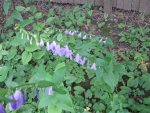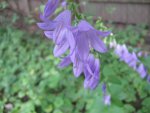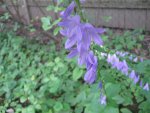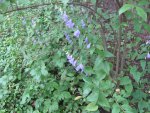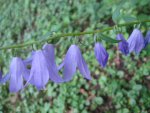Hello All!
We have a very attractive mystery flowering plant that arrived last year and came back this year. I'm hoping one of you recognizes it and can give it a name so I can learn about it.
My wife called them weeds, but aren't weeds just desirable plants that no one thought to put a price tag on?
They are range about 2 -3 feet tall and are sparsely distributed. Today they are tipped over, but it is super hot and the ground has been soaked since winter, so maybe those factors are contributing. Usually they stand upright and sway gently in the breeze.
We don't know where they came from, since I don't see them in anywhere else in the neighborhood. (Squirrels, rabbits or birds must have donated the seeds, I guess.) We've been here over 30 years and never saw them until last year.
In our yard, we have a long, wide strip along a fence that we leave natural for the birds, squirrels and rabbits. ("Natural" in this context means most of what shows up can stay, as long as it doesn't take over. We received some really nice tiger lilies that way!)
Our "Nature Conservancy" strip is where most of these plants are located. That area gets partial sun due to several maple trees shading it. A few of these flowering plants are in the front yard under some pine tree branches.
I don't know if this helps with the identification diagnosis, but these plants live happily in a tough environment of 2" - 3" of dirt over clay with dozens of competing plants. They're mostly mixed in with the tiger lilies.
They didn't get any artificial help growing since we don't use any pesticides or fertilizers on our property. Many of those chemicals are very mean to birds, insects, worms and animals who walk through them- plus, I'd imagine, the aquifer; so we skip them. We do leave lots of plant residue to decompose naturally.
I've searched all the on-line images that I could find and came up empty. I asked at a garden center & the people didn't know. ("Weeds! Get Rid Of Them!"- Translation: We don't sell them, so they are weeds.)
The flowers showed up this week. This year's timing might be misguiding, since it was mostly cold and rainy until a couple of weeks ago. If I remember correctly from last year, the flowers last for most of the summer.
Attached are some photos. (Ansel Adams I am not, so if the images are crummy, please let me know & I'll take some more.)
Thanks For Helping me figure this out. I enjoy learning about plants (an excuse to be outdoors).
Enjoy This Day!
Paul
PS: I hope this is in the correct section & apologize if I picked wrong. I picked Perennials because the plant in question came back this year on its own.
We have a very attractive mystery flowering plant that arrived last year and came back this year. I'm hoping one of you recognizes it and can give it a name so I can learn about it.
My wife called them weeds, but aren't weeds just desirable plants that no one thought to put a price tag on?
They are range about 2 -3 feet tall and are sparsely distributed. Today they are tipped over, but it is super hot and the ground has been soaked since winter, so maybe those factors are contributing. Usually they stand upright and sway gently in the breeze.
We don't know where they came from, since I don't see them in anywhere else in the neighborhood. (Squirrels, rabbits or birds must have donated the seeds, I guess.) We've been here over 30 years and never saw them until last year.
In our yard, we have a long, wide strip along a fence that we leave natural for the birds, squirrels and rabbits. ("Natural" in this context means most of what shows up can stay, as long as it doesn't take over. We received some really nice tiger lilies that way!)
Our "Nature Conservancy" strip is where most of these plants are located. That area gets partial sun due to several maple trees shading it. A few of these flowering plants are in the front yard under some pine tree branches.
I don't know if this helps with the identification diagnosis, but these plants live happily in a tough environment of 2" - 3" of dirt over clay with dozens of competing plants. They're mostly mixed in with the tiger lilies.
They didn't get any artificial help growing since we don't use any pesticides or fertilizers on our property. Many of those chemicals are very mean to birds, insects, worms and animals who walk through them- plus, I'd imagine, the aquifer; so we skip them. We do leave lots of plant residue to decompose naturally.
I've searched all the on-line images that I could find and came up empty. I asked at a garden center & the people didn't know. ("Weeds! Get Rid Of Them!"- Translation: We don't sell them, so they are weeds.)
The flowers showed up this week. This year's timing might be misguiding, since it was mostly cold and rainy until a couple of weeks ago. If I remember correctly from last year, the flowers last for most of the summer.
Attached are some photos. (Ansel Adams I am not, so if the images are crummy, please let me know & I'll take some more.)
Thanks For Helping me figure this out. I enjoy learning about plants (an excuse to be outdoors).
Enjoy This Day!
Paul
PS: I hope this is in the correct section & apologize if I picked wrong. I picked Perennials because the plant in question came back this year on its own.


